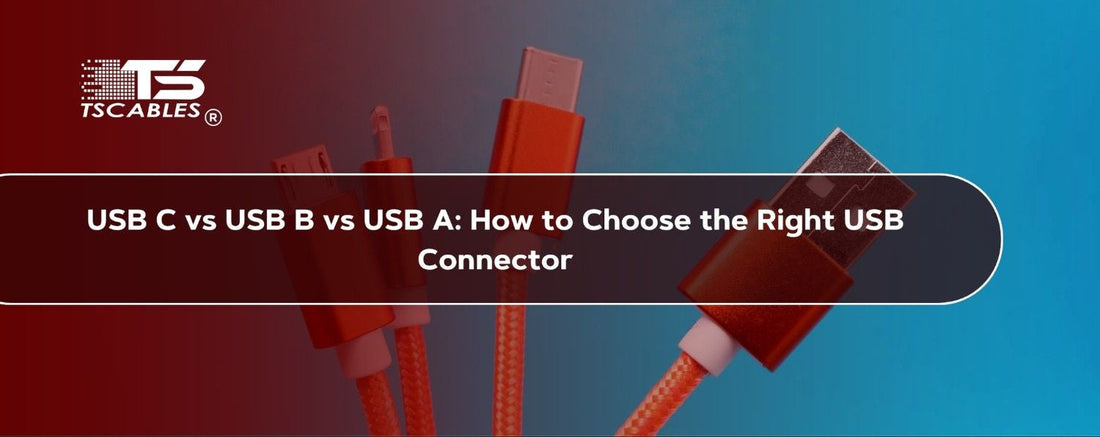USB connectors are everywhere. They power devices and help in moving files. It is safe to say that they keep everything connected. Yet most people still get confused when choosing between USB-A, USB-B, and USB-C. Each connector has its own look and use with a different performance level.
Knowing the difference saves time and keeps you from buying the wrong cable. So, which one should you choose? This article will provide you with a clear idea of the differences among all three USB connectors. IT will ensure that you choose the right one according to your needs and preferences.
USB: The Basics
USB stands for Universal Serial Bus. It was created to make connections simple between computers and devices. Before USB, people used ports that were slow and messy. Over time, USB improved with:
- Faster speeds
- Smaller designs
- Wider use
Today, the types of USB include many shapes and sizes. However, the main connectors people deal with are USB-A, USB-B, and USB-C.
USB-C, USB-B, and USB-A: Key Differences You Need to Know
Choosing the right connector starts with knowing how they differ. These connectors vary in shape and purpose. Some are common in computers, while others are found in printers or new phones. The best way to pick one is to understand where each one fits.
USB-A
USB A is the classic connector most people recognize. It is flat and rectangular. You usually see it on:
- Laptops
- TVs
- Gaming consoles
It is usually attached to the standard cable you use for keyboards, mice, or flash drives. This classic connector has been around for decades and remains common.
USB-B
USB-B is larger and squarer. It is mostly used in older devices. You will notice it in:
- Printers
- Scanners
- External hard drives
Over time, smaller connectors replaced USB B. However, it is still seen in equipment that requires steady data transfer.
USB-C
USB-C is the newest and most advanced option. It is slim and oval-shaped. The USB-C connector works in both directions, so you never plug it in wrong. Many modern laptops and other devices use USB Type-C for charging and data. It is also powerful enough to carry video signals for monitors.
What Is USB Used For?
USB connectors serve many purposes. They transfer data between devices and supply power for charging. In addition to that, they also link various gadgets to computers, such as:
- Cameras
- Phones
- Game controllers
They also support accessories such as storage drives and printers. Every type of USB was made to fit a specific role in this process.
How Has USB Improved Over the Years?
USB has gone through many upgrades since it first appeared. Speeds improved from slow transfers to lightning-fast rates. Charging ability expanded so that one port could power almost any device.
Newer versions also reduced the size of connectors. This makes them more practical for portable gadgets. These steps explain why different USB types exist today.
What Improvements Does USB-C Bring?
USB Type-C is more advanced than older connectors. It has better speed and stronger power delivery. Not only that, but it also offers more flexibility. Before exploring each benefit, it is worth noting that USB-C and USB-A often work together through adapters or hybrid cables. This makes the shift to new devices smoother.
Faster Speeds
The USB-C connector supports high data transfer speeds. Moving large files like movies or backups happens quickly. This saves time and makes it ideal for professionals and everyday users.
More Power for Charging
USB-C provides more charging power than older connectors. It can charge laptops and other electronic devices with the same cable. That means fewer chargers are needed.
Reversible Design
The design of USB Type-C is easy to use. It plugs in either way. This means that users avoid the struggle of flipping cables around.
Video and Audio Support
USB-C does more than carry power and data. It also handles video and audio. Many monitors now use USB-C instead of HDMI.
Wider Compatibility
While USB-C is modern, it connects with older types of USB through adapters. This ensures people can still use existing devices while upgrading.
Are There Any Downsides to USB-C?
Although USB Type-C is advanced, there are a few downsides. Not all cables are equal. Some may charge more slowly or transfer data poorly. The move from USB-A and USB-B to USB-C can also be confusing for people with older gear. Keep in mind that the benefits still outweigh the drawbacks.
Final Thoughts
Choosing between USB-A, USB-B, and USB-C comes down to what device you use. Older hardware may need USB-B. On the other hand, everyday accessories often rely on USB-A. Modern devices shine with USB Type-C. Each connector has its place, but USB-C is clearly the future.
TS Cables offers reliable solutions for every type of USB. You can trust TS Cables for quality and durability from classic USB-A to the latest USB Type-C.
FAQs
Q1: What is a USB cable used for?
It connects devices like keyboards, flash drives, and mice to computers.
Q2: Are all USB-C cables the same?
No. Some carry faster speeds and more power than others. Always check the specifications.
Q3: Can USB-C replace HDMI?
Yes. Many USB-C connectors carry video and audio for monitors and projectors.
Q4: Why are there different USB types?
Each type of USB was created to support different devices, speeds, and functions.
Q5: Is USB-B still in use?
Yes. It is mainly used in printers and older storage devices. It is less common today.





